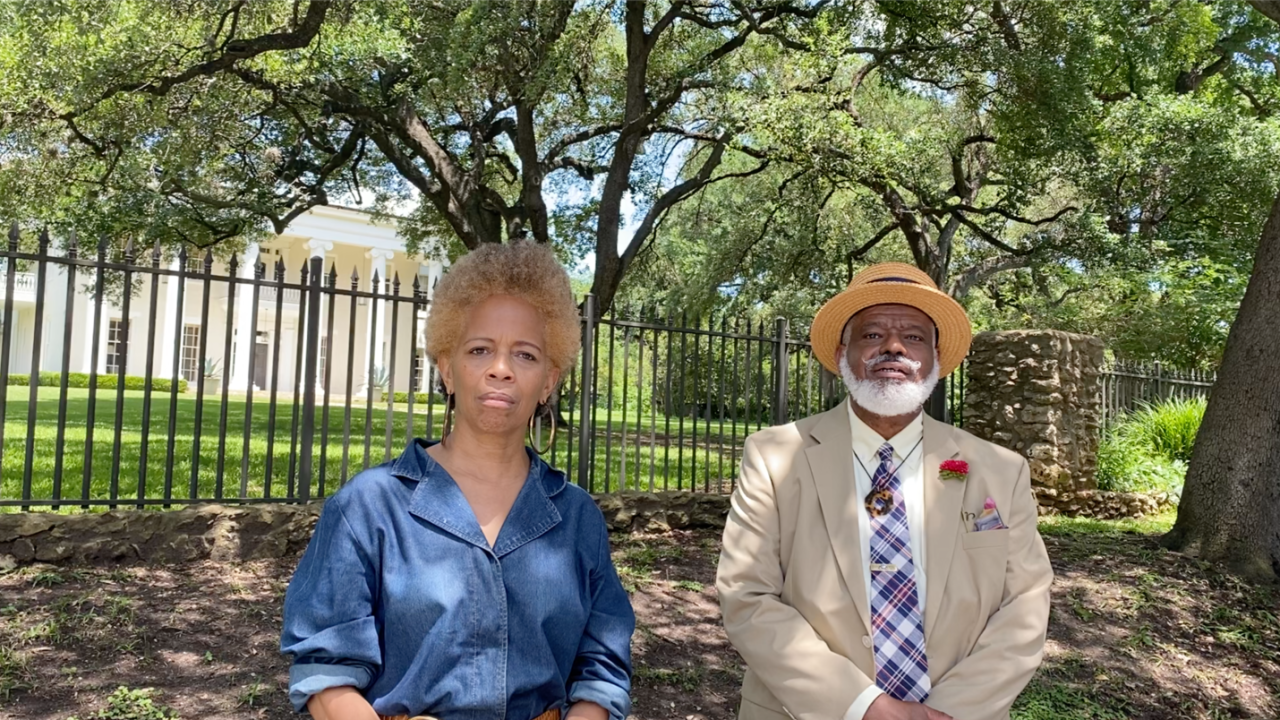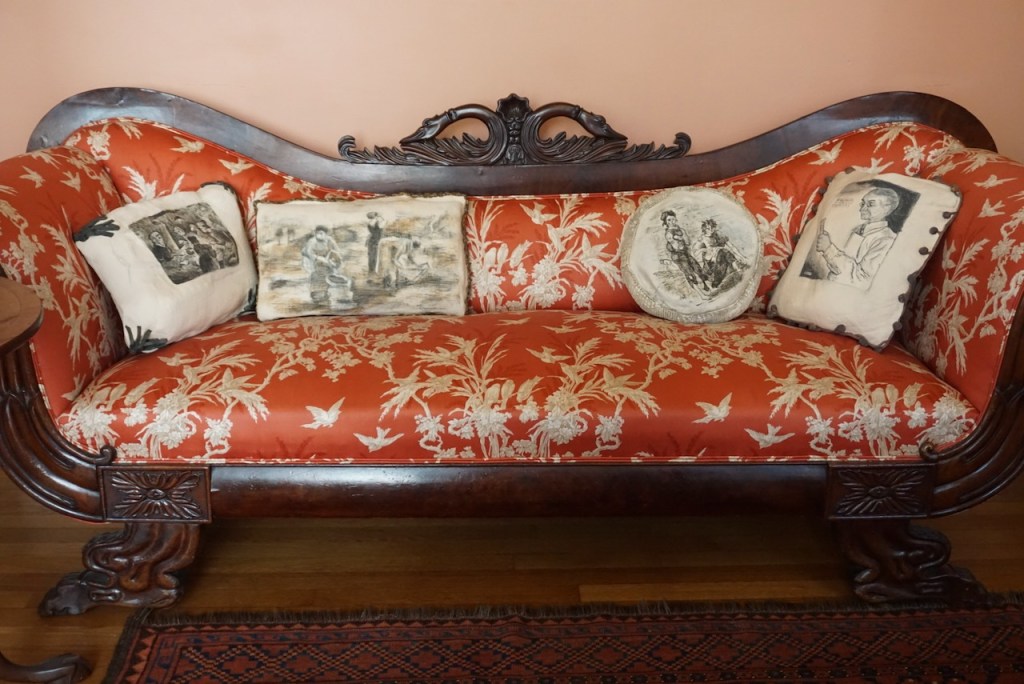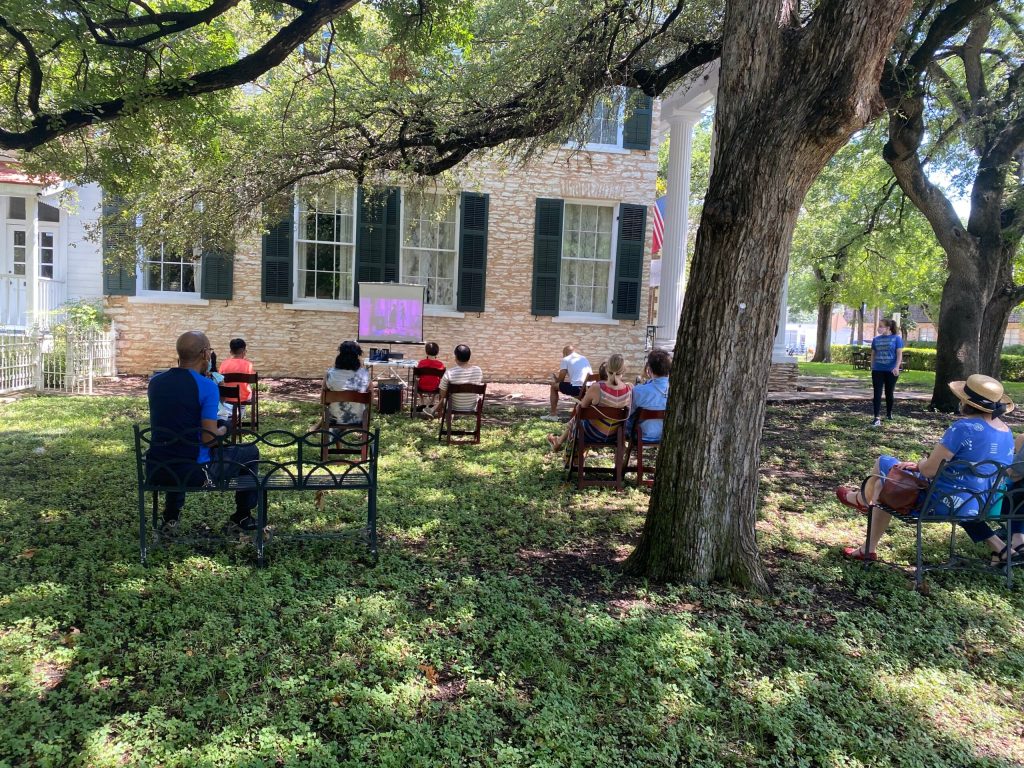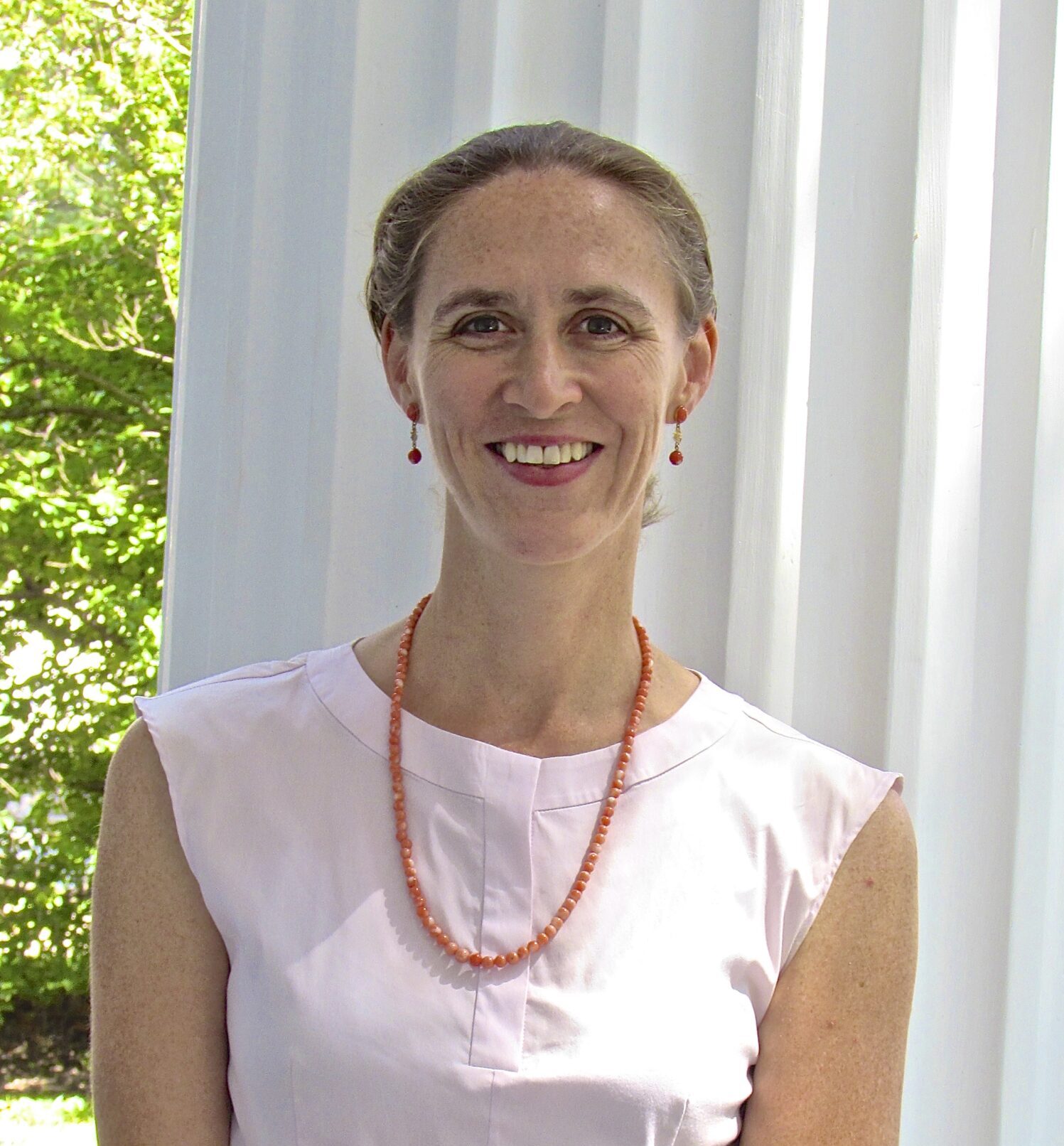
Lately, at the Neill-Cochran House Museum we’ve spent a lot of time thinking about what community means, and the best way we can define it for our institution. This question has become even more critical since the COVID-19 pandemic descended upon us in March. I know we are not alone in recognizing the need to focus on hyperlocal tourism for the foreseeable future. For those of us who historically have been destinations for traveling tourists, those visitors will be few and far between into 2021 at least.
We’re located in the middle of Austin, Texas, so we do have a neighborhood: West Campus, the part of town the city has encouraged University of Texas at Austin students to populate for decades. On one level, West Campus is our community—these are the folks we see walking by us daily, and we’ve done our best to draw them in. Our three-quarter-acre site encompasses the only green space left in our neighborhood, and it’s always a thrill to see students walk their dogs on our grounds, take a turn on our rope swing, and even get some schoolwork done on our porch.
But community means much more than that, and it’s only in the last couple of years that we have come to a deeper understanding of how much more, and how hard we need to work to build the equitable community we would like to reach.
History of the Neill-Cochran House Museum
The Neill-Cochran House Museum (NCHM) is an 1856 Greek Revival home, among the ten oldest residences in Austin, and includes the city’s only intact slave quarters. We interpret Austin’s first one-hundred-plus years, from its founding in 1839 up to 1958 when The National Society of The Colonial Dames of America in the State of Texas purchased the site from the Cochran family in order to open it as a museum.
When the museum first opened in 1962, we focused primarily on offering Austinites the opportunity to learn about American history and decorative arts (generous Dames and friends had furnished the house with beautiful antiques). Over time, we shifted towards heritage tourists, who wanted to know who lived on our site and what their lives were like. Ironically, the museum only started to emphasize Austin history based on these questions from travelers—not when we initially targeted Austinites as visitors.
Heritage Tourists vs. Bringing in the Locals
For several years now, the museum has been pivoting towards greater engagement with Austinites, but this can be an uphill climb. Heritage tourists are the low-hanging fruit for a historic house museum (HHM) such as ours. They’re out there looking for places to visit, so we don’t have to work too hard to court them. They come, they pay admission, they maybe purchase something in the gift shop, and they go. We hope to provide a good experience, but rarely do heritage tourists build a long-term relationship with sites they visit while traveling.
It is the locals—our communities—who are the challenge, and that is particularly true for HHMs. For many locals, the traditional view of an HHM is, “Oh, the Neill-Cochran House Museum—I went there once.” In other words, box checked. It takes great effort to change this view, but the effort is worth it—if you want to be relevant, you need your communities. To reach them, though, you need to be a resource for them. They must need you as much as you need them.
To achieve this, you can’t be static. The thing is, most of us don’t change our installations often—we tell stories predicated on a furnishings plan (often put together at great expense) connected to our site history, which rarely changes. How frequently do you replace your furniture at home? Exactly.
So, what’s an HHM to do? It comes down to programming and exhibits, and right now we are in the middle of something big on both counts.
If These Walls Could Talk

In January of this year, the NCHM opened a major exhibition and collaborative project entitled If These Walls Could Talk. The project represents two years of conversation and planning between the museum, visual artist Ginger Henry Geyer, and actor and storyteller Jennifer Rousseau Cumberbatch. The concept began as a retrospective of Geyer’s career, in which we planned to disrupt our historically installed interiors with contemporary trompe l’oeil porcelain artwork. However, as Geyer became more familiar with our site and its history, particularly the significance of the slave quarters, the show transformed. She brought Jennifer Cumberbatch to the table, adding performance to the increasingly complex project.
For the exhibition, we have hosted six major events, including performances based on Geyer’s provocative sculptures, which pose questions about the people who built, worked at, and lived near the NCHM. In the process, we have participated in important conversations about our city’s difficult and complex racial history and have welcomed an increasingly diverse audience—racially, ethnically, and geographically (in terms of zip codes). From the opening of the project on January 15 to today, we have welcomed over twelve hundred participants. For us, that number is a big one, particularly with two-and-a-half months’ closure due to COVID-19.

The exhibition falls in a long line of shows the NCHM has mounted over the past few years to achieve our mission in sharing Austin and American history with our visitors. More to the point though—and I cannot stress this enough—these shows provide locals with reasons to return to the museum multiple times each year.
Juneteenth Weekend Driving Tour
The themes of If These Walls Could Talk put the NCHM in a position to provide leadership, education, and conversation about racial politics and culture in Austin in the wake of George Floyd’s murder in Minneapolis on May 26.
When the murder happened, our team had already been working to translate a sold-out bus tour we offered in February to a self-paced driving tour, as a safe alternative during COVID-19. The tour explored Black history in Central West Austin, an area surrounding our museum, making it a fitting activity for the weekend of Juneteenth. Our tour ended up being one of the only opportunities in Austin to commemorate Juneteenth in person, rather than virtually. As a health precaution, we limited our numbers, and not only sold out the weekend—with more than one hundred visitors each day on Friday through Sunday—but filled the following full week for timed admission to the museum.

Our visitors’ responses were powerful. One woman, white and in her late twenties, said that she had lived in Clarksville (one of Austin’s original Freedman communities featured on the tour) and now lives in East Austin (the area of town people of color were coerced to move to in the wake of the segregationist 1928 City Plan). Her employer was giving everyone Juneteenth off, and she registered for our tour because she didn’t want that day to be “just another day off”—she wanted to learn something. An eight-year-old girl, also white, told her mother she learned more on the tour than she ever had in school. A grandmother—Black, in her sixties, and accompanied by her grandson—said that she choked up more than once while watching our orientation film and then walking through the slave quarters. She loved what we were doing and that she could share Black history with her grandson both on our site and through the tour.
All of the programming related to If These Walls Could Talk has drawn a more diverse audience than we normally see at our lectures and for regular tours. We have welcomed many millennials, families with young children, and people of color of all ages.
What We’ve Learned
We have learned a lot over the past few years through trial and error, and we continue to learn today through the work we have done with If These Walls Could Talk. Here are some of the things we’ve discovered:
Building a diverse community is hard.
Our loyal core of supporters originates from a lecture series we established fifteen years ago called Modern Times. We developed a dedicated audience for that series, and then used that audience to expand our reach through new exhibits and other types of programming. These supporters have helped us to welcome new visitors through their enthusiasm and faith in what they know we can do.
But this group of history buffs looks pretty homogenous—white, older, highly educated. Our challenge, if we want to continue to build community and relevance, is to diversify the group of people who feel passionately that the NCHM is an important cultural and community resource for our city.
You need to understand your communities to reach them.
Though Austin is known as a liberal bubble in the midst of red Texas, we as a city have not committed to true equity over the course of our history. For example, even though our county was one of only three in the South to vote against secession in 1861, our progressive champions in that stand were themselves enslavers.
At the NCHM, it has taken us years to understand that not all Austinites feel welcome at our site, for reasons rooted in that history of systemic racism. Through the 1928 City Plan, the city coerced people of color to move away from central and west Austin, away from us. Today, it is still a real challenge to welcome people of color to our site. If These Walls Could Talk is finally beginning to erode the barriers, thanks to inclusive programming and messaging and substantial PR efforts, both through paid advertising and earned media.
Different audiences will show up for different things.
Not everyone will come out for family programming. Not everyone loves a lecture. I know, that’s hard to hear for many of us. (It’s hard for me to hear, if I’m honest!) But many people who don’t want to give up their Sunday afternoon or Thursday evening for a lecture will come out for a performance-based event, for instance.
If you want to go hyper-local, you’re going to need to meet your community or communities where they are. Build different offerings that support your mission but encourage non-traditional audiences to join you.
Building community bridges will help you down the road.
I was asked recently whether I thought it was possible for institutions to pivot quickly in the wake of George Floyd’s murder to respond to the groundswell of emerging consciousness of racial inequality. My short answer is—no! We were only able to participate productively in a conversation about race and equity because our work was well underway. If you are not there yet, my advice is to start your process, with resolve and in deep conversation with the communities you wish to serve. There is no shortcut.
As we move through 2020 and into 2021, those “easy” heritage tourist visitors I mentioned are likely to be scarce, due to the pandemic. But that scarcity has challenged us to connect to the residents of our own city. Thankfully, we had already shifted our strategy towards welcoming an increasingly diverse local audience to the NCHM through wide-ranging programming. These are the people who will care five, ten, twenty, or fifty years from now whether the Neill-Cochran House Museum historic site remains a fixture in our urban scene. And they’re worth fighting for.
About the author:
Rowena Houghton Dasch has been the Executive Director of the Neill-Cochran House Museum since 2013. She holds a BA degree in Art & Archaeology from Princeton University, and MA and Ph.D. degrees in Colonial and nineteenth-century American art from The University of Texas at Austin.









Most interesting article. You have addressed some of the things our VS department has been considering. Thank you, Cecilia